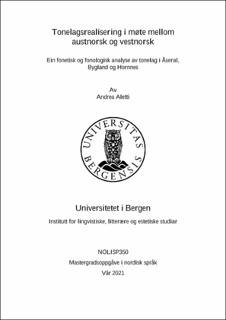Tonelagsrealisering i møte mellom austnorsk og vestnorsk. Ein fonetisk og fonologisk analyse av tonelag i Åseral, Bygland og Hornnes.
Master thesis
Permanent lenke
https://hdl.handle.net/11250/2762958Utgivelsesdato
2021-06-02Metadata
Vis full innførselSamlinger
- Master theses [242]
Sammendrag
Denne oppgåva undersøker tonelagsrealisering hos 9 informantar frå tre nabokommunar ved grensa mellom dei tidlegare fylka Vest- og Aust-Agder. Agder utgjer eit interessant område når det gjeld tonelagsrealisering i og med at isoglossen som tradisjonelt deler dei norske dialektane inn i høgtone- og lågtonedialektar, går nettopp der. Meir i detalj er dialektane i Aust-Agder rekna med som lågtonedialektar, medan dialektane i Vest-Agder er tradisjonelt høgtonedialektar. Dei tre kommunane som utgjer studieområdet i oppgåva – Åseral i Indre Vest-Agder og Bygland og Hornnes i Aust Agder – representerer kvar sin tonelagstypologi, på linje med den tradisjonelle inndelinga av dei norske dialektane. Det fyrste forskingsspørsmålet i denne oppgåva er å gje ein autosegmental representasjon av dei ulike tonelagsrealiseringane som finst i analysematerialet mitt i håp om å finne meir ut av tonelagsvariasjonen i området. Analysen min baserer seg på opptak frå eit tidlegare arbeid. Innspelingane blei samla inn frå Knut Fintoft rundt 1970 og blei seinare bruka av Fintoft og Per Egil Mjaavatn (1980) som metodisk grunnlag i den fyrste fonetiske kartlegginga av tonelagsvariasjonen i dei norske dialektane. Det andre forskingsspørsmålet er å utfordre dei fonetiske gjennomsnittskurvene som Fintoft og Mjaavatn (1980) tildelte som representative for tonelagsrealiseringane i Indre Vest-Agder (Åseral) og Aust Agder (Bygland og Hornnes). Teoriane og metodane som er bruka i denne undersøkinga har grunnlag i to fonologiske modellar for analyse av tonar. Den fyrste er den Autosegmentale Fonologien, som analyserer dei fonologiske tonane i eit tonalt forløp i samband med segmentstrukturen i det relevante domenet. Den andre er Det Tonale Prosodiske Hierarkiet, som forklarer den prosodiske strukturen i ei gitt ytring. Metodane og framgangsmåten i analysen er inspirerte av tidlegare fonologisk tonelagsforking som supplerer ein tradisjonell fonetisk analyse av tonelagskurven med meir moderne fonologiske autosegmentale analysar av tonar. Som forventa, viser analyseresultata ein meir variert situasjon enn den som kartlegginga i Fintoft og Mjaavatn (1980) presenterer. Tonelagsvariasjonen kjem til uttrykk både på intraindividuell og interindividuell nivå og kan forklarast frå eit diakront perspektiv som baserer seg på timing-hypotesen. I denne hypotesen er tonelagskontrasten og tonelagsutvikling i diakroni forklart som resultat av høgreforskyving av tonar i det tonale forløpet. Forskjellen mellom dei autosegmentale representasjonane mine og gjennomsnittskurvene i Fintoft og Mjaavatn (1980) er primært forårsaka av dei manglande fonologiske opplysingar i gjennomsnittskurvene, som i nokre tilfelle fører til ukomplette representasjonar av tonelagskontrasten. I tillegg har eg også analysert tilfelle der tonelagssystema hos informantane avvik typologisk frå den forventa prosodien i området, og også eit tilfelle som viser eit blanda tonelagssystem med element frå både høgtone- og lågtoneprosodien. This thesis investigates the structure of the tonal accents among 9 informants from 3 different neighboring municipalities in the county of Agder in Southern Norway. Agder is an interesting area as regards the different phonological structures of the tonal accents in the county’s dialects. This is related to the tonal isogloss that divides the Norwegian dialects into two main categories, high-tone and low-tone dialects. The isogloss divides also the dialects of Eastern Agder from the dialects of the Western part, creating a typological prosodic difference between the dialects in the county. The three municipalities that are the subject of this study are at the borderline of the imaginary isogloss, one representing the Western tonal accent (Åseral) and the other two representing the Eastern tonal accent (Bygland and Hornnes). One of the main purposes of this thesis is to provide an autosegmental representation of the tonal accents used in the area in order to find out more about the tonal accent variation in those borderline municipalities. My analysis is based on recordings which were collected around 1970, and were later used for the first phonetic mapping of tonal variation in the Norwegian dialects by Knut Fintoft and Per Egil Mjaavatn in 1980. The other main purpose of this study is to question the phonetical curves given as representative for the tonal melodies in three municipalities of Åseral, Bygland and Hornnes. The theories and methods applied in the thesis are grounded in two main models for phonological analysis of tonal properties in languages. The first is Autosegmental Phonology, which aims at analysing the tonal melodies in relation to the segmental structure in the relevant domain. The second is the Tonal Prosodic Hierarchy, which is a model of representation of the prosodical structure of a given utterance. The methods and procedures in the analysis are inspired by modern research on Norwegian tonal accents that implement an autosegmental phonological analysis to a more traditional acoustic and phonetical analysis of tonal curves. The results show, as expected, a more varied picture than what shown by the phonetic average curves for the two areas in the mapping from Fintoft and Mjaavatn (1980). This variation is both inter-individual and intra-individual and can be explained from a diachronic point of view, in line with timing-based theories for tonal development. This is mainly due to the fact that the phonetic curves in Fintoft and Mjaavatn (1980) do not provide phonological information that relates the tonal curves to the segmental structure in the utterances, hence leading to an incomplete representation of the tonal contrast in the dialects of the region. In addition, I have also found cases in which the tonal accent structures used by the informants differ typologically from the expected prosodies of the local areas, as well as a case of mixed tonal accent system with elements from both the high-tone and low-tone typology.
